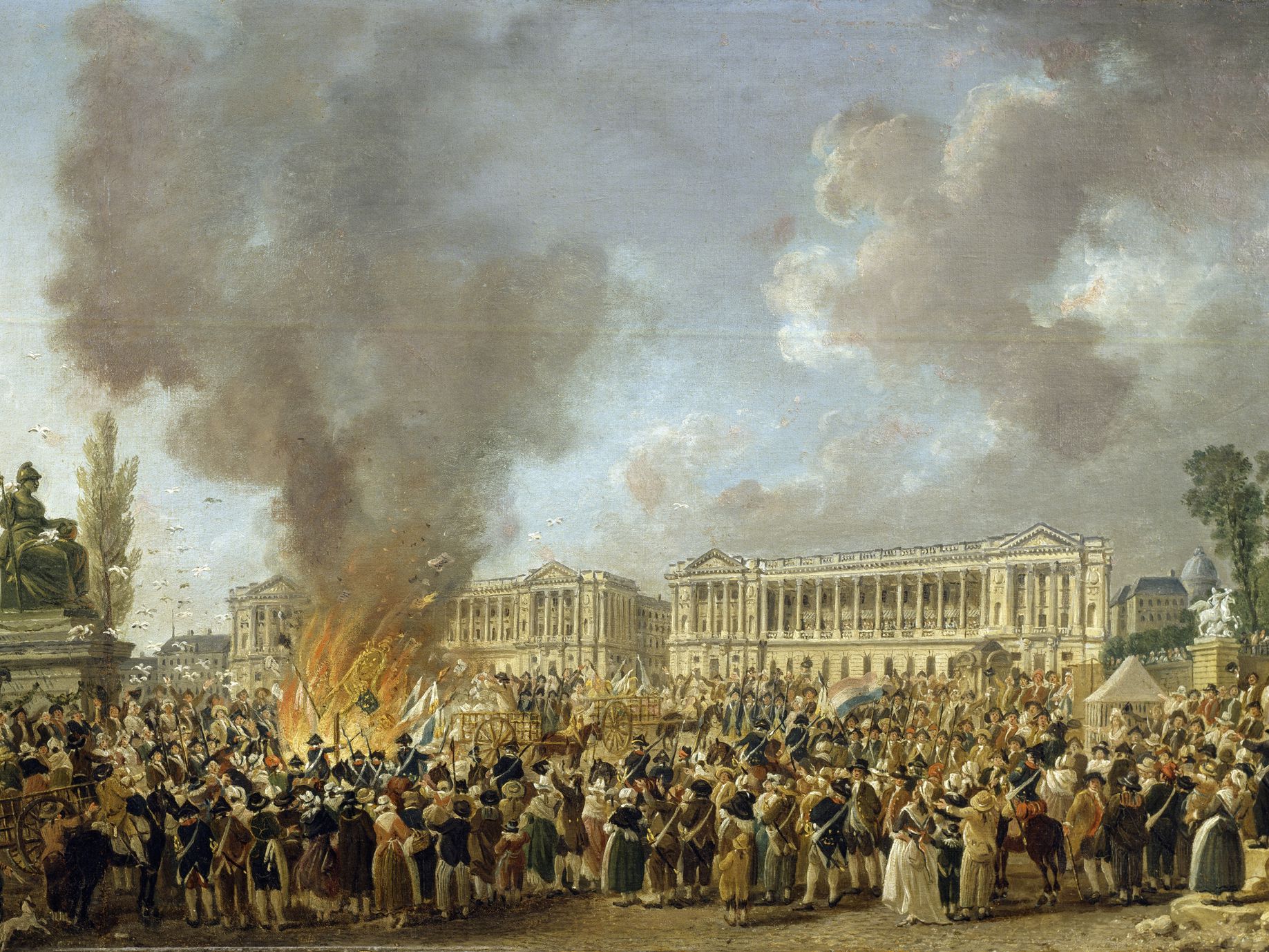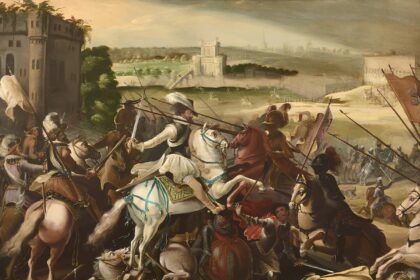All those who opposed the current authority in France were either imprisoned or put to death during the Reign of Terror, a terrible and bloody period of the French Revolution. Between 1793 and 1794, the First Republic faced a number of challenges, both from beyond and within its borders. These included the Federalist revolts and the Vendean uprising, as well as the march of foreign forces seeking to re-establish the monarchy in France. The Convention, spurred on by Maximilien Robespierre, initiated a harsh crackdown on individuals it labeled “counter-revolutionaries” out of concern that these rival factions might eventually join forces and derail the Revolution’s progress. Fear among opponents quickly grew as a result of a series of arbitrary arrests, summary executions, and massacres that occurred in a span of less than two years.
When did the Reign of Terror take place in France?

The Convention (the assembly that ran the First Republic) decreed the “Reign of Terror” on September 5, 1793: “Terror is the order of the day.” With the arrest of the Jacobins and the death of Robespierre, the Reign of Terror ended on July 28, 1794.
Since the monarchy of Louis XVI and France was toppled in 1792, this made a place for the formation of the Convention. The Marais, the Girondins, and the Montagnards were the three main political groups represented in this new legislature (radical revolutionaries of which the Jacobins were part). The Jacobins led by Robespierre were prepared to use dramatic measures to win over the masses. The 31st of May, 1793, was the day when Robespierre and his followers finally acted.
On that day, leading Girondins were guillotined after being overthrown by the Montagnards. Robespierre was now able to rule France with an iron fist and root out any last counter-revolutionaries. Federalist revolts erupted in the south and west of France in response to this seizure.
How did the Montagnards establish the Reign of Terror?
Paradoxically, Robespierre and the Jacobins, who claimed to be defending people’s freedom, actually presided over a dictatorship based on the most fundamental instrument of repression: the Revolutionary Tribunal. This is where the Reign of Terror got its start. It was first initiated on March 10, 1793 which authorized the public trials and guillotines for the regime opponents. It was decided that the Girondins would pay the price for being viewed as too moderate. The Law of Suspects, one of the many tools of the Reign of Terror, was enacted on September 17, 1793. There was a wide definition of “counter-revolutionary” given in the document:
“Those who, by their conduct, associations, talk, or writings have shown themselves partisans of tyranny or federalism and enemies of liberty; those who are unable to justify, in the manner prescribed by the decree of 21 March last, their means of existence and the performance of their civic duties; those to whom certificates of patriotism have been refused; […] those former nobles, husbands, wives, fathers, mothers, sons or daughters, brothers or sisters, and agents of the émigrés, who have not manifested their devotion to the Revolution.”
Law of Suspects
However, Robespierre and his followers still felt this was not satisfactory. In a decree issued on October 10, 1793, the Convention declared that “the government of France will be revolutionary until the peace,” an idea that had originated with Saint-Just. In other words, the Constitution of 1793 was not being applied and personal freedoms were not being considered until peace was restored. The Convention passed a new law on Law of 22 Prairial Year II (10 June 1794), which did away with both the right to a defense and the right to questioning by the prosecution. The Revolutionary Tribunal could have either found one not guilty or sentenced the person to death.
What were the causes of the Reign of Terror?

There were both domestic and international security concerns, thus the Reign of Terror was instituted to cope with them. To resist the French revolutionaries and restore the monarchy from the outside, a coalition of other European countries was created.
However, the First Republic was still threatened at the time of the 1792 Battles of Valmy and Jemmapes. The counter-revolution united many different groups inside the nation, such as monarchists and those opposed to mass conscription for war, as well as recalcitrant priests (those who rejected the Civil Constitution of the Clergy). The tensions in the nation were already high when the Vendeans and the Chouans revolted in 1793.
Amid mounting opposition, the French Revolution instituted the Reign of Terror in an attempt to protect itself. There had been numerous changes since 1789 due to the Revolution, and the old orders of aristocracy and church had not always taken well to them. The monarchy held on for a while, but in the summer of 1792, King Louis XVI was accused of treason. As a result of this incident, revolutionary beliefs became more extreme, and the monarchy was overthrown.
A precursor to the Reign of Terror that would be implemented the following year, the September Massacres of 1792 served as an early warning. Historians have even argued that this event marked the start of the Reign of Terror. With the trial and killing of the monarch, the formation of the Revolutionary Tribunal and the Committee of Public Safety, the law of suspects, the trial and execution of the queen, and the eradication of the Vendean rebels, the new republic opted to escalate into the Terror.
The aftermath of the Reign of Terror
As a result of the “Terror” and the Law of 22 Prairial, the representatives decided to topple Maximilien de Robespierre. With Robespierre’s execution on July 28, 1794, the Reign of Terror came to an end. To forestall another Reign of Terror, the authorities created a new constitution. As a result of the switch from universal to census suffrage, minorities and the economically disadvantaged were no longer able to vote in elections.
To prevent the rise of a new dictatorship, the powers that are primarily controlled by the bourgeoisie were further decentralized, with two assemblies presiding over the legislative and five directors presiding over the executive. France’s religious freedom was restored on February 21st, 1795. The human cost was also high, particularly in regions where repression was particularly harsh, like the Vendée. Over 170,000 people were killed during the Wars of the Vendée (War in the Vendée). During the Reign of Terror, approximately half a million people were incarcerated and 40,000 were killed.
Did the Reign of Terror threaten the First Republic?
Even while terror was established to keep the new republic safe, it ended up posing a threat to its survival. Maximilien de Robespierre and his followers contended during the Reign of Terror that the only way to defend the First Republic from the European kings who had invaded France was with a draconian rule. In contrast, Georges Danton advocated for peace in a speech given in November 1793, arguing that a nonviolent and moderate approach was consistent with the survival and prosperity of the First Republic. Danton and his “indulgent” associates were guillotined on April 5, 1794, for embezzlement.
KEY DATES OF THE REIGN OF TERROR

September 22, 1792: Abolition of the French Monarchy
The Convention immediately dissolved the monarchy upon its formation, using its legal authority to do so. The Year I of the Republic was proclaimed the next day.
December 10, 1792: The Trial of Louis XVI
Louis XVI’s trial lasted more than two weeks, from December 10-26, 1792. The verdict was delivered on January 15, 1793: Deputies voted overwhelmingly in favor of the monarch’s death. He was accused of fleeing to Varennes, of ordering foreign forces to fire on his own people and of treason.
January 21, 1793: Death of Louis XVI
On January 21, 1793, Louis XVI was executed by guillotine in the Place de la Révolution (Place de la Concorde). His wife, Marie Antoinette, followed him to the scaffold on October 16.
February 23, 1793: The Convention decides the conscription of 300,000 men
In order to resist enemy aggression, the revolutionary army needed to strengthen its armed forces. The Girondins, in charge of the Convention, decided to recruit 300,000 more soldiers for the French army. As in Lyon, the population reacted negatively to this massive recruitment drive. The Vendée Wars were based on this situation.
March 10, 1793: Creation of the Revolutionary Tribunal
The Revolutionary Tribunal was established by the Convention as an “extraordinary criminal court” to cope with domestic dangers and counter-revolution. The Republic’s prosecutor decided whether or not to bring charges against those under investigation. The Revolutionary Tribunal stayed in operation until May 31, 1795.
May 31, 1793: The Girondins are overthrown by the Montagnards
Overthrowing the Girondins by the Montagnards on May 31, 1793, marked the official start of the Reign of Terror. Montagnards and capital sans-culottes responded to Robespierre’s appeal to surround the Convention and demand the resignation of Girondin representatives for their incompetence in handling the foreign invasion. As a direct result of this action, 25 Girondin lawmakers were beheaded.
September 17, 1793: The Convention votes on the “Law of Suspects”
The Convention votes for the “Law of Suspects” on September 17, 1793, the eve of instituting the Reign of Terror. All “counter-revolutionaries” were subject to arrest and prosecution under this statute. It was revoked after Robespierre’s execution since it endangered those who were not totally dedicated to the Revolution.
October 10, 1793: Saint-Just declares the “Revolutionary Government”
Saint-Just announced on October 10, 1793, that the government would continue its revolutionary course until a formal declaration of peace was made. Liberties for all individuals were put on hold until peace was restored, and a new revolutionary calendar was instituted.
October 14, 1793: Marie Antoinette before the Revolutionary Tribunal
The Revolutionary Tribunal presided over Marie Antoinette’s trial on October 14, 1793. During her rule, she was criticized for allegedly immoral behavior and erratic spending patterns, as well as for allegedly planning and cooperating with foreign powers.
October 16, 1793: Marie Antoinette is guillotined
Marie Antoinette’s execution at the Place de la Révolution took place on the day of her conviction on October 16, 1793. Her trial lasted barely two days.
October 26, 1793: Couthon begins the destruction of Lyon
Robespierre’s trusted ally, Georges Couthon, was sent to Lyon to put down the uprising and destroy the neighborhoods where it began. When it came to coordinating the repression, it was Couthon, as a member of the Committee of Public Security, who was in command. However, he couldn’t bring himself to carry out the Convention’s mandate, and was eventually replaced.
November 6, 1793: Philippe-Egalité dies on the scaffold
Philippe-Egalité was put to death by guillotine in late 1793. He was accused of wanting to bring back the monarchy. The Duke of Orleans, on the other hand, was a passionate revolutionary who had not hesitated to vote for Louis XVI’s death. In 1792, Louis-Philippe Joseph d’Orléans changed his name to Philippe-Egalité. From April on, he was locked up in Marseille. During the July Monarchy, his son Louis-Philippe I became king.
November 10, 1793: Notre-Dame de Paris, Temple of Reason
To make room for the cult of the Supreme Being, Notre-Dame de Paris was turned into a Temple of Reason. The deists created this new religion to represent the ideals of the Republic. In accordance with the Convention, this new religion would take the place of the Catholic faith.
November 24, 1793: The publication of the revolutionary calendar
On November 24th, 1793, a new calendar, called the revolutionary calendar or the republican calendar, was instituted. It has months of thirty days with names that recall the seasons (such as brumiaire, floréal, and fructidor) and weeks of 10 days.
January 21, 1794: Turreau’s infernal columns attack the Vendée
After the destruction of the Vendée army at Savenay on January 21, 1794, incendiary columns led by General Turreau were in operation until May 17, 1794. These columns terrorized the locals to no end as they went about their mission of wiping out the last remaining insurgent strongholds of the Vendée Wars by means of massacring the populace, destroying the agricultural infrastructure, and seizing the animals. The Convention settled on this “scorched-earth” approach in an effort to appease the Vendée.
April 5, 1794: Danton and Desmoulins at the scaffold
About fifteen “indulgent” persons, including Georges Danton, Camille Desmoulins, Hérault de Séchelles, and Fabre d’Eglantine, were tried by the Revolutionary Tribunal on April 2, 1794. While fighting Robespierre, Danton was accused of embezzlement. On April 5, 1794, they were guillotined.
May 7, 1794: The Cult of the Supreme Being
The cult of the Supreme Being was based on a series of events where deist Montagnards came together for civic and religious celebrations. Robespierre put this cult in place on May 7, 1794, to fight against the Cult of Reason, which had been set up by Hebdo revolutionaries the previous fall.
June 10, 1794: The Convention decrees the Reign of Terror
A lawyer and merchant named Georges Couthon, who was influenced by Robespierre, drafted the Law of 22 Prairial on June 10, 1794. With the reform of the Revolutionary Tribunal, this statute raised the Reign of Terror rule in France to a whole new level. The goal was to streamline the process by eliminating some steps, such as the defense’s opening statement and the accused person’s questioning. The “Terror” had thus begun.
July 28, 1794: End of the Reign of Terror and Fall of Robespierre
The Law of 22 Prairial, which was passed in June, was the last thing that made people stop supporting Robespierre. Maximilien Robespierre, also known as “the incorruptible,” was arrested and shot in the jaw on July 27, 1794. The next day, he and about twenty other Montagnard supporters were guillotined in the public square, along with Couthon, Saint-Just “the Archangel of Terror,” and Couthon. The Reign of Terror was over, and the Convention set up the more moderate Thermidorian Republic (Thermidorian Convention). The Jacobin Club was closed for good.
Bibliography:
- Jean-Clément Martin, La machine à fantasmes, Paris, Vendémiaire, 2014, 314 p p. (ISBN 978-2-36358-029-0), p. 86-118
- Hervé Leuwers, Robespierre, Paris, Fayard, 2014
- Halsall, Paul (1997). “Maximilien Robespierre: On the Principles of Political Morality, February 1794”. Fordham University.
- Marjorie Bloy. “The First Coalition 1793-1797.” A Web of English History. https://plato.stanford.edu/archives/sum2014/entries/montesquieu/.
- Cléry, Jean-Baptiste; Henry Essex Edgeworth (1961) [1798]. Sidney Scott (ed.). Journal of the Terror. Cambridge: Cambridge University Press. OCLC 3153946.
- Mathiez, Albert (2011). La Révolution Française. Librairie Armand Colin. ISBN 978-7-100-07058-4.
- Linton, Marisa, Choosing Terror: Virtue, Friendship and Authenticity in the French Revolution (Oxford University Press, 2013).
- Gough, Hugh. The terror in the French revolution (London: Macmillan, 1998)
- Hibbert, Christopher (1981). The Days of the French Revolution. New York: Quill-William Morrow. ISBN 978-0-688-16978-7.
- Loomis, Stanley (1964). Paris in the Terror. New York: Dorset Press. ISBN 978-0-88029-401-0.





